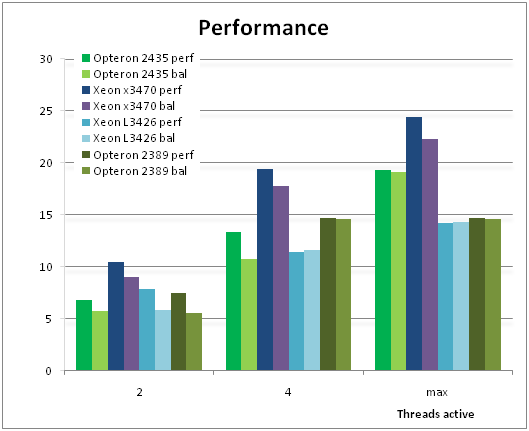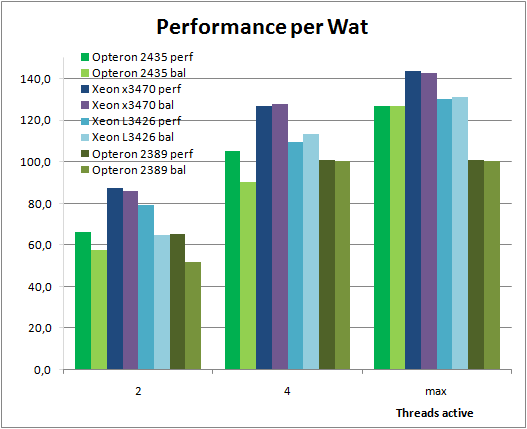Dynamic Power Management: A Quantitative Approach
by Johan De Gelas on January 18, 2010 2:00 AM EST- Posted in
- IT Computing
Overview
So let's summarize what we have seen so far. First we look at system power.

At the system level, the power savings of the Balanced power plan are pretty disappointing. Especially when benchmarking with two threads, we would have expected better power savings. Of course, we tested with only one CPU. The power savings should be better as you add more CPUs to the server. On the X3470 power savings are better, but the reason is not so much "SpeedStep" but more the fact that this turns off Turbo Boost. The most spectacular power savings cannot be seen in this picture: the automatic power and clock gating. As we have shown in this article, power and clock gating happen in both power plans and are responsible for some very significant savings, especially on the "Nehalem Lynnfield" Xeons. SpeedStep and PowerNow! are no longer very impressive for the following reasons:
- Clock gating and "deep sleep" core C-states already save a lot of power
- They are limited to frequency scaling; voltage scaling is only possible if all cores are running at a low P-state
In the case of Intel, frequency scaling is demoted to a pretty insignificant role: it is more important to power gate cores than to clock them down to a lower P-state.

For AMD, P-state changes are still important, but their effect is dubious: performance is up to 20% lower. Even the specific AMD driver in Windows 2008 (amdppm.sys) is not capable of working optimally under low load. Cores frequently stay at 800MHz too long or only get to 1400MHz before a thread is moved to another core. Ideally our two thread benchmark should get at least two CPU cores to quickly ramp up to 2.6GHz and stay there, but that's not what happened in our tests.
We'll make a simple performance/watt calculation by multiplying the performance numbers by 1000 and dividing them by our power numbers.

Look at the green bars of the AMD Opteron processors: performance/watt is clearly lower when running in Balanced mode. This is of course not the case when we run four threads on the quad-core and six threads on the six-core Opteron. In that case the operating system gets very few chances to drop the power. Still, it is important to note that PowerNow! results in a significant performance loss, a performance loss that is not justified by the meager power savings. The result is that the six-core Opteron in Performance mode offers the best performance/watt ratio when we focus on the Opteron family. It is a shame that the Windows 2008 CPU driver does not adapt better: the six-core Opteron is pretty competitive in performance/watt.
The situation is a lot more complex in the Intel Xeon family. With low thread counts, the Xeon is capable of using Turbo Boost. From a "system power" perspective, power is only a bit higher, while performance goes up by a third. But with low TDPs, there is little wiggle room, and Turbo Boost is quickly put out of action. With more than two threads, the L3426 never clocks above 1.86GHz. With "normal" Xeons, there is no significant difference between the two power plans.










35 Comments
View All Comments
JohanAnandtech - Monday, January 18, 2010 - link
In which utility do you set/manage the frequency of a separate core?n0nsense - Monday, January 18, 2010 - link
Gnome panel applets. CPU frequency monitor I guess it uses cpufreq. Each instance monitors core. So i have 4 of them visible all the time. If you have enabled CPU Frequency scaling (kernel) than you can select the governor (performance, on demand, conservative etc) or a static frequency. I can do it for each core. And it displays what i have set.Of course processor should support frequency scaling.(power now and speed step).
Most mainstream distributions (Ubuntu, Sabayon, Fedora) will use onedemand governor by default when processor with frequency scaling available. No user intervention required.
jordanclock - Monday, January 18, 2010 - link
I really think you're mistaken. Core 2 CPUs don't have any mechanism to allow per-core frequencies. There is one FSB clock and one multiplier. There is no way to set CPU0 to a different frequency than CPU1 (or for quad core, CPU2 and CPU3) because the variables that control the clock speed are chip wide.VJ - Tuesday, January 19, 2010 - link
These people seem to be convinced of per-core Speedstep:https://bugs.launchpad.net/ubuntu/+source/linux-so...">https://bugs.launchpad.net/ubuntu/+source/linux-so...
Maybe someone can ask David Tomaschik for the Intel documentation he refers to?
n0nsense - Monday, January 18, 2010 - link
I heard it in past, but i still tend to believe my eyes :)while writing this reply, i saw any possible combination. My Q9300 has 2 states 2.0GHz and
2.5GHz. It's not a server CPU. Have no reason to mislead you
VJ - Tuesday, January 19, 2010 - link
If there's only two states, then it's possible that one core is in the C2 state while the other is in its C0 state.The core in state C2 may be shown to be operating at 2Ghz (its lowest frequency) while it's really off. The OS may simply be reporting the lowest possible frequency while the core is really not receiving a clock signal.
So in general, if one core is showing its lowest frequency it may be off which still allows the other core to operate (at a different frequency).
It would be very strange if both cores are operating greater than their lowest and less than their highest frequencies at different frequencies.
From a different angle: Has anybody ever seen /proc/cpuinfo report a frequency less than the CPU/Core's lowest active frequency or even zero? Probably not.
n0nsense - Tuesday, January 19, 2010 - link
Nice theory :)But in this case, I see that each core doing something. htop shows that each core somewhere in 15% usage. So the only options left, are
1. Each core frequency can be controlled independently on C2D and C2Q (May be i3 i5 i7 too)
2. The OS is completely unaware of whats going on :) (which is less possible)
mino - Thursday, January 21, 2010 - link
"The OS is completely unaware of whats going on" is the right answer.:)
BTW, only x86 CPU's able to change freq per core are >=K10 for AMD and >=Nehalem for Intel.
VJ - Tuesday, January 19, 2010 - link
Not to defeat your argument/observations, rather for completeness' sake:It's also possible that the differences are due to the reading of the attributes. If the attributes are read in succession, then it's possible that the differences are due to the time of reading the attributes, while at any given instant, notwithstanding the allowable subtle differences in frequency described in this article, all cores are operating at the same frequency.
There's a lot of time at the bottom.
JanR - Tuesday, January 19, 2010 - link
Hi,I completely agree to this:
"It's also possible that the differences are due to the reading of the attributes."
The point is that desktop usage together with ondemand governor leads to a lot of fast frequency changes. Therefore, this is not a good scenario to decide on "per core" vs "per CPU". We did a lot of testing the following way:
Put load on all cores using "taskset" (this avoids C-states). Switch to "userspace" governor and then set frequencies of individual cores differently. You have one control per core but the actual hardware decides what really happens - you can check this in /proc/cpuinfo or using a tool such as "mhz" from lmbench as load generator (this one calculates actual frequency based on CPI and time, it allows also measurement of turbo frequencies).
Trying around, the results are:
AMD K8: One clock domain, maximum of the requested frequencies is taken
Intel Core2 Duo: Same as K8
AMD K10: Individual clock domains, you can clock each core individually
Intel Core 2 Quad: TWO clock domains! These CPUs are two dual core dies glued together so each die has its one multiplicator. Therefore, the cores of each die get the maximum of the requested frequencies but you can clock the two dies independendly.
Intel Nehalem: One clock domain, maximum of requests of all cores that are not in C-state! If you set one core to, e.g., 2.66 GHz and all other to 1.6, all cores clock at 1.6 as long as the core set to 2.66 is not used, they all switch to 2.66 if you put load on that core.
So far to our findings. "cat /proc/cpuinfo" or some funny tools are useless if you do not control the environment (userspace, manual settings). If you then enable ondemand, the system switches fast between different states and looking at it is just a snapshot, maybe taken in the middle of a transition.
Greetings,
Jan